牛津译林版(2019)必修第二册Unit 2 Be sporty, be healthy. Extended reading 课件(共22张PPT)
文档属性
| 名称 | 牛津译林版(2019)必修第二册Unit 2 Be sporty, be healthy. Extended reading 课件(共22张PPT) | 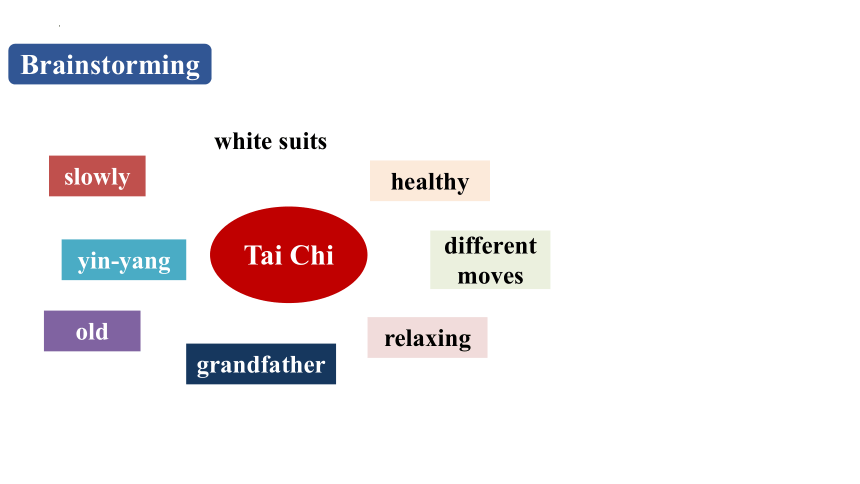 | |
| 格式 | pptx | ||
| 文件大小 | 4.5MB | ||
| 资源类型 | 教案 | ||
| 版本资源 | 牛津译林版(2019) | ||
| 科目 | 英语 | ||
| 更新时间 | 2024-03-04 08:57:54 | ||
图片预览

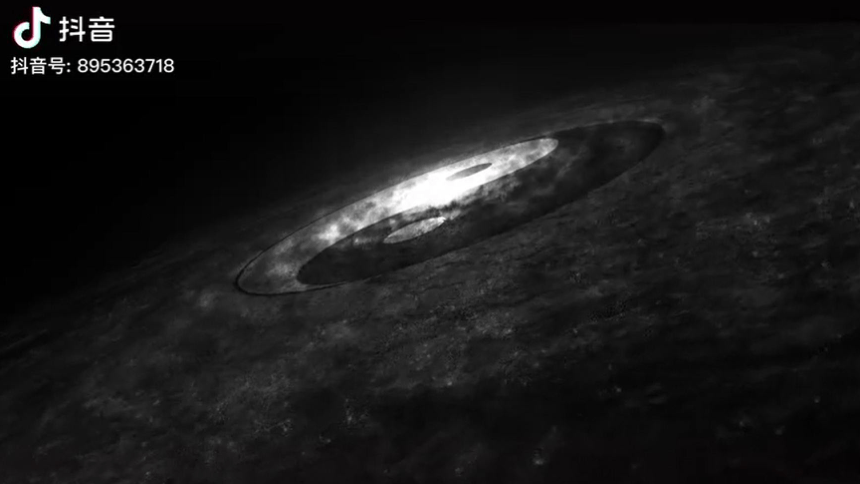

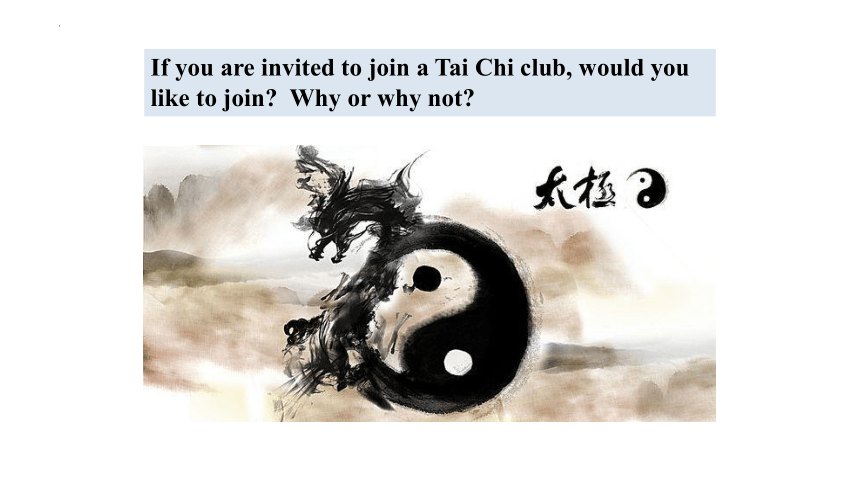
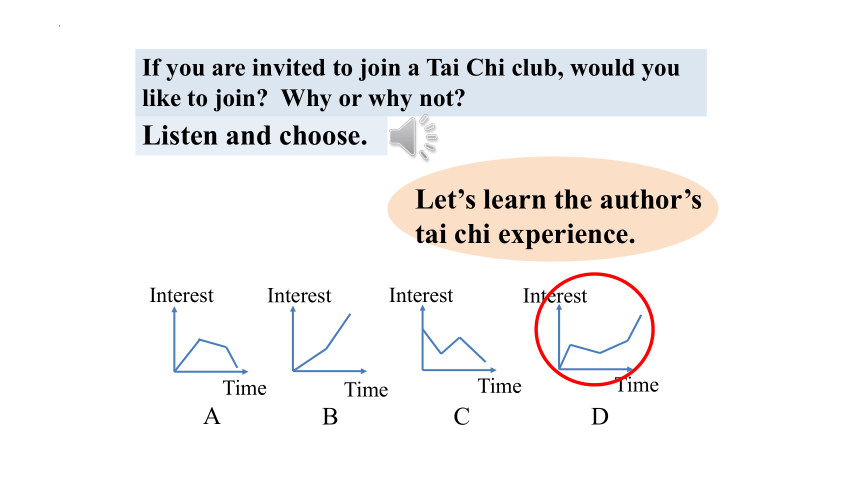


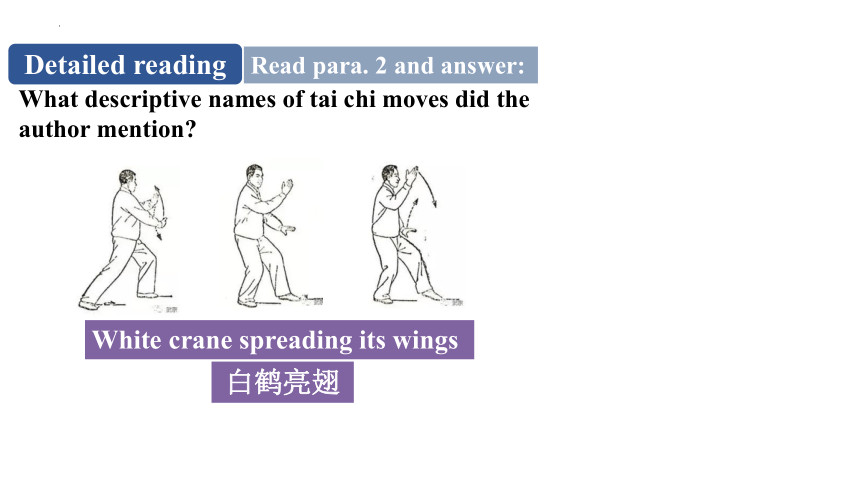
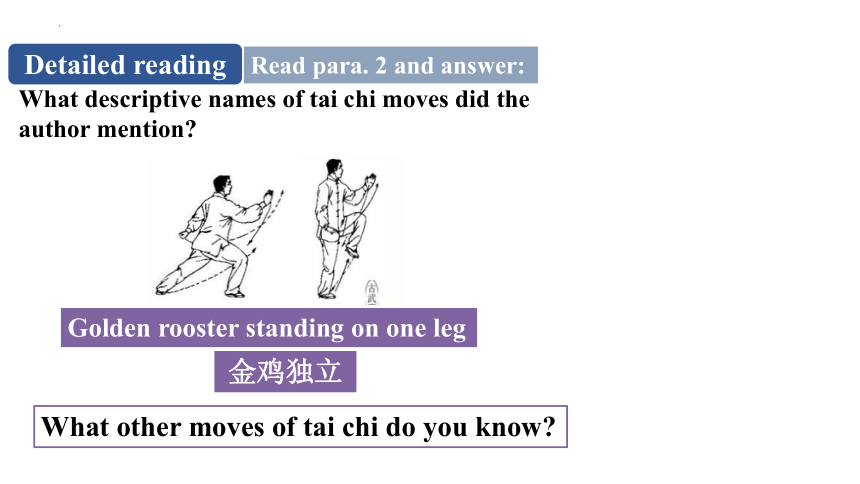
文档简介
(共22张PPT)
Brainstorming
Tai Chi
slowly
yin-yang
old
grandfather
white suits
healthy
different moves
relaxing
Brainstorming
Tai Chi
slowly
yin-yang
old
grandfather
white suits
healthy
different moves
relaxing
If you are invited to join a Tai Chi club, would you like to join Why or why not
If you are invited to join a Tai Chi club, would you like to join Why or why not
Listen and choose.
Time
Interest
Time
Time
Time
Interest
Interest
Interest
A
B
C
D
Let’s learn the author’s tai chi experience.
Time Feelings Reasons
Change 1:
Change 2
When his friend suggested
After learning the basics of tai chi
bored and aching
fun and easy
hesitatant
doing the same moves over and over again
moves caught his imagination;
was told about the history
for old people
The first few tai chi classes
Detailed reading
Time Feelings Reasons
Change 3
Change 4
Detailed reading
happier and more confident
satisfied
After his coach’s guidance
A year of practising tai chi
positive effects & benefits
balance and flexibility improved
Read para. 2 and answer:
What descriptive names of tai chi moves did the author mention
White crane spreading its wings
白鹤亮翅
Detailed reading
Read para. 2 and answer:
What descriptive names of tai chi moves did the author mention
Golden rooster standing on one leg
What other moves of tai chi do you know
金鸡独立
Detailed reading
手挥琵琶
倒卷肱
右蹬脚
Detailed reading
Detailed reading
海底针
单鞭
左揽雀尾
What are the two different explanations for the origin of tai chi
One is related to Zhang Sanfeng, a 13th-century Taoist. It is said that he invented tai chi after drawing inspiration from a fight between a snake and a bird.
The other is that tai chi was developed based on martial arts skills by a 17th-century master of Chinese martial arts--Chen Wangting.
Read para. 2 and answer:
Detailed reading
Essence of tai chi
Chinese philosophy of ____________
the unity of _____________
The practice of tai chi aims to maintain the balance in the body through
______________
breathing in and breathing out
yin and yang
opposites
opposite movements
forwards and backwards
up and down
left and right
Read para. 4 and complete the chart.
Detailed reading
What’s your understanding of Chinese philosophy of yin and yang
“Yin and Yang -- the Mother of Ten Thousand Things”
As this quote from Lao Tzu suggests, Tai Chi derives its name from the concept of yin and yang, also known as the Tai Chi symbol. Yin and yang is a central concept in traditional Chinese medicine, philosophy, and science, and it is one of the deepest pillars of Chinese culture.
Discussion
What’s your understanding of Chinese philosophy of yin and yang
The yin-yang symbol, now a very popular symbol in the West as well, depicts two complementary polar opposites that, together, create a dynamic, balanced, integrated, and inter-dependent whole.
Tai Chi training embodies this yin-yang concept at multiple levels.
Discussion
What’s your understanding of Chinese philosophy of yin and yang
At the most obvious, physical level, Tai Chi is an exercise that aims to strengthen, stretch, balance, and coordinate and integrate the left and right halves of the body, the upper and lower halves of the body, and the extremities of the body with the inside or core.
Discussion
What’s your understanding of Chinese philosophy of yin and yang
At a more subtle level, Tai Chi integrates body and mind. Body movements are coordinated with rhythmic, conscious breathing and multiple cognitive and emotional components—including focused attention, heightened self-awareness, visualization, imagery, and intention.
----Derived from the Harvard Medical School Guide to Tai Chi
Discussion
In line 32, the author mentioned “there is no shadow without light”. Why is it used here
This example explains the unity of opposites.
Neither can exist independent without the other.
Discussion
Can you make up more examples to explain the unity of opposites
There is no good without evil.
There is no fairness without unfairness.
There is no white without black.
There is no beauty without ugliness.
There is no success without failure.
…
We live in a balanced world.
Discussion
Life itself is a balanced, complementary gains and losses, which is a dynamic relationship.
生活本来就是一种平衡,是得失互补的动态关系。
Homework
Recite para. 4.
Finish the extra exercise.
Thank you
Brainstorming
Tai Chi
slowly
yin-yang
old
grandfather
white suits
healthy
different moves
relaxing
Brainstorming
Tai Chi
slowly
yin-yang
old
grandfather
white suits
healthy
different moves
relaxing
If you are invited to join a Tai Chi club, would you like to join Why or why not
If you are invited to join a Tai Chi club, would you like to join Why or why not
Listen and choose.
Time
Interest
Time
Time
Time
Interest
Interest
Interest
A
B
C
D
Let’s learn the author’s tai chi experience.
Time Feelings Reasons
Change 1:
Change 2
When his friend suggested
After learning the basics of tai chi
bored and aching
fun and easy
hesitatant
doing the same moves over and over again
moves caught his imagination;
was told about the history
for old people
The first few tai chi classes
Detailed reading
Time Feelings Reasons
Change 3
Change 4
Detailed reading
happier and more confident
satisfied
After his coach’s guidance
A year of practising tai chi
positive effects & benefits
balance and flexibility improved
Read para. 2 and answer:
What descriptive names of tai chi moves did the author mention
White crane spreading its wings
白鹤亮翅
Detailed reading
Read para. 2 and answer:
What descriptive names of tai chi moves did the author mention
Golden rooster standing on one leg
What other moves of tai chi do you know
金鸡独立
Detailed reading
手挥琵琶
倒卷肱
右蹬脚
Detailed reading
Detailed reading
海底针
单鞭
左揽雀尾
What are the two different explanations for the origin of tai chi
One is related to Zhang Sanfeng, a 13th-century Taoist. It is said that he invented tai chi after drawing inspiration from a fight between a snake and a bird.
The other is that tai chi was developed based on martial arts skills by a 17th-century master of Chinese martial arts--Chen Wangting.
Read para. 2 and answer:
Detailed reading
Essence of tai chi
Chinese philosophy of ____________
the unity of _____________
The practice of tai chi aims to maintain the balance in the body through
______________
breathing in and breathing out
yin and yang
opposites
opposite movements
forwards and backwards
up and down
left and right
Read para. 4 and complete the chart.
Detailed reading
What’s your understanding of Chinese philosophy of yin and yang
“Yin and Yang -- the Mother of Ten Thousand Things”
As this quote from Lao Tzu suggests, Tai Chi derives its name from the concept of yin and yang, also known as the Tai Chi symbol. Yin and yang is a central concept in traditional Chinese medicine, philosophy, and science, and it is one of the deepest pillars of Chinese culture.
Discussion
What’s your understanding of Chinese philosophy of yin and yang
The yin-yang symbol, now a very popular symbol in the West as well, depicts two complementary polar opposites that, together, create a dynamic, balanced, integrated, and inter-dependent whole.
Tai Chi training embodies this yin-yang concept at multiple levels.
Discussion
What’s your understanding of Chinese philosophy of yin and yang
At the most obvious, physical level, Tai Chi is an exercise that aims to strengthen, stretch, balance, and coordinate and integrate the left and right halves of the body, the upper and lower halves of the body, and the extremities of the body with the inside or core.
Discussion
What’s your understanding of Chinese philosophy of yin and yang
At a more subtle level, Tai Chi integrates body and mind. Body movements are coordinated with rhythmic, conscious breathing and multiple cognitive and emotional components—including focused attention, heightened self-awareness, visualization, imagery, and intention.
----Derived from the Harvard Medical School Guide to Tai Chi
Discussion
In line 32, the author mentioned “there is no shadow without light”. Why is it used here
This example explains the unity of opposites.
Neither can exist independent without the other.
Discussion
Can you make up more examples to explain the unity of opposites
There is no good without evil.
There is no fairness without unfairness.
There is no white without black.
There is no beauty without ugliness.
There is no success without failure.
…
We live in a balanced world.
Discussion
Life itself is a balanced, complementary gains and losses, which is a dynamic relationship.
生活本来就是一种平衡,是得失互补的动态关系。
Homework
Recite para. 4.
Finish the extra exercise.
Thank you
